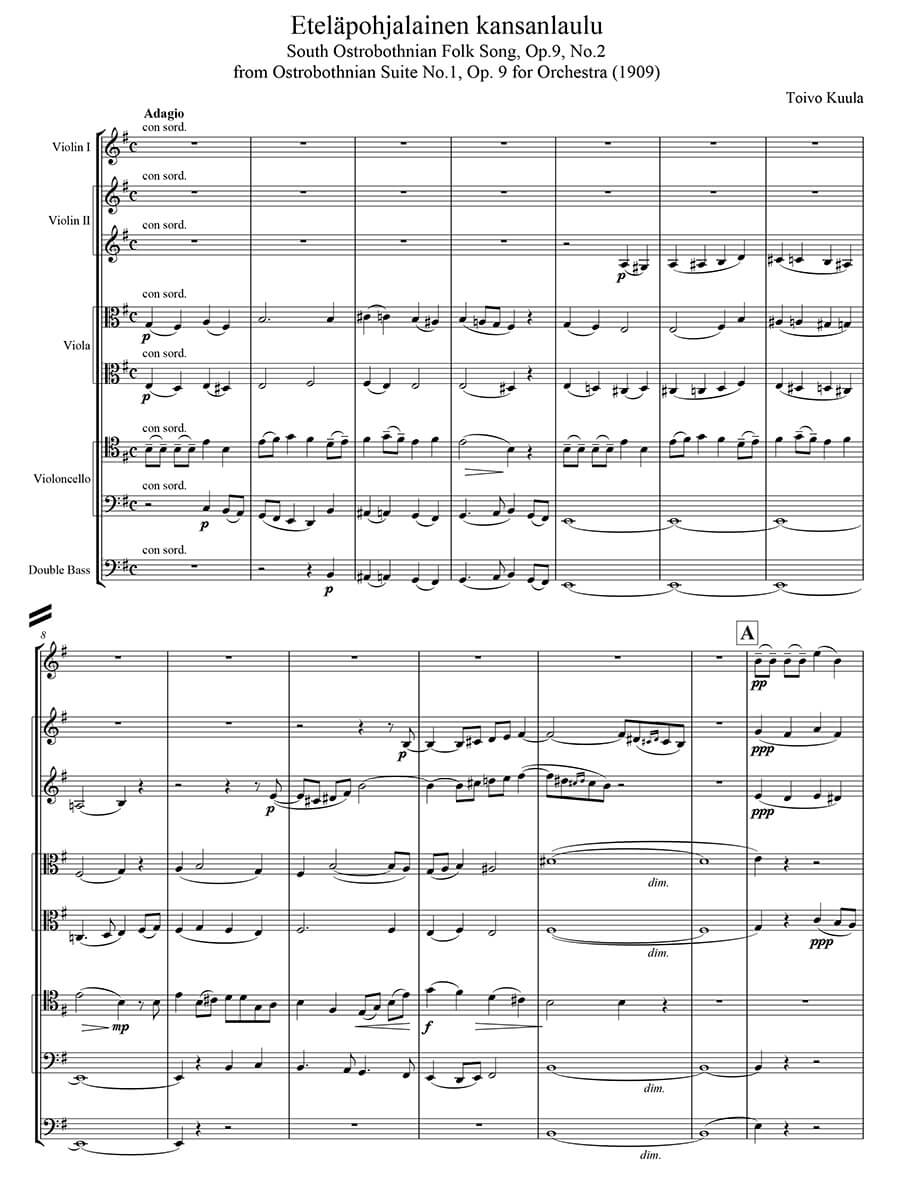Eteläpohjalainen kansanlaulu (South Ostrobothnian Folk Song for string orchestra / Second Movement from ‚South Ostrobothnian Suite’ No. 1 op. 9 / first printed edition, prepared from the manuscript by Lucian Beschiu)
Kuula, Toivo
10,00 €
Toivo Kuula – ‘Eteläpohjalainen kansanlaulu’ South Ostrobothnian Folk Song for string orchestra
(b. Vaasa, 7 July 1883 – d. Viipuri, 18 May 1918)
Second Movement from South Ostrobothnian Suite No. 1, Op. 9 (1909)
Preface
Toivo Kuula, along with the slightly younger Leevi Madetoja (1887-1947), was the most creative Finnish composer in the generation after Jean Sibelius. Before he had reached the age of thirty-five, his life came to an abrupt end in the turbulent aftermath of the Finnish Civil War, when he was shot by a paramilitary soldier he had taunted.
Kuula studied at Helsinki Conservatory, where his teachers included Martin Wegelius (1846-1906), Armas Järnefelt
(1869-1958), and Jean Sibelius (1865-1957), and received further training in Bologna from Marco Enrico Bossi (1861-
1925) and in Paris from Marcel Labey (1875-1968). In 1910-11 he was a conductor in Oulu, and from 1911 to 1915 he served as deputy conductor of the Helsinki City Orchestra. In 1916 he took charge of the orchestra in Viipuri (Vyborg in Russia since 1940), where he met his death.
In Finland, Kuula still remains popular above all as a composer of vocal music, especially of choral songs. His output of orchestral and chamber music is fairly small. A Jupiter Symphony was left unfinished, and the especially popular Stabat Mater (1914-18) was premièred in Helsinki in 1919 in a completion by Leevi Madetoja.
Kuula was an Ostrobothnian who hailed from the harbor town of Vaasa on the Gulf of Bothnia. Throughout his life he remained close to the folk music of his native region; even the bulk of his orchestral music relates directly to the folk legends and melodies of Southern Ostrobothnia. Perhaps his most important orchestral work is Orjan Poika (Son of a Slave), Op. 14b, of 1912.
In 1906 Kuula composed two orchestral pieces in Vaasa that are both based on folk tunes: Ostrobothnian Dance and Devil’s Polka. Another three pieces were added in 1909 during his studies with Bossi at Bologna Conservatory: Lands- cape, the present Folk Song for string orchestra, and Song of Twilight (the same year also witnessed a Prelude and Fugue for orchestra, Op. 10). Later he combined the five pieces to create the First South Ostrobothian Suite for orchestra, Op.
9. In 1912-13 he composed a Second South Ostrobothnian Suite for orchestra, Op. 20, likewise in five movements. With its gruff, archaic intimacy and its at once skillful and distinctive counterpoint, Folk Song from the First Suite is one of the most moving string miniatures of its time. Probably no musician of our day has confronted this music with such authentic, ungarnished, earthy expression as has Juha Kangas with his Ostrobothnian Chamber Orchestra in Kokkola (documented on recordings for Caprice Records and Alba Records). It is to him that we dedicate the present printed edition, prepared from the manuscript by Lucian Beschiu.
Translation:Bradford Robinson
For performance material please contact Musikproduktion Höflich (www.musikmph.de), Munich.
Deutsches Vorwort > HERE
| Edition | Repertoire Explorer |
|---|---|
| Genre | String Orchestra |
| Pages | 12 |
| Size | 225 x 320 mm |
| Performance materials | aivailable |
| Printing | New print / Urtext |
| Size | 225 x 320 mm |
